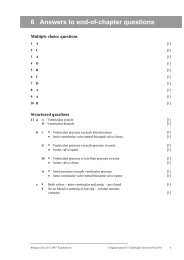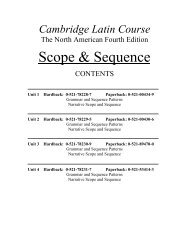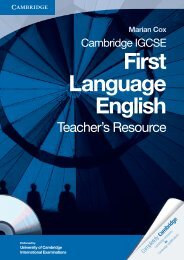Brad Philpot - Cambridge University Press
Brad Philpot - Cambridge University Press
Brad Philpot - Cambridge University Press
Create successful ePaper yourself
Turn your PDF publications into a flip-book with our unique Google optimized e-Paper software.
Part 3 – Literature: texts and contexts<br />
144<br />
EE<br />
Extended<br />
essay<br />
William Blake: laying the<br />
foundations of Romanticism.<br />
‘Middlemarch’: the epitome of<br />
realism in English literature.<br />
Understanding post-modernism<br />
through Paul Auster’s ‘New York<br />
Trilogy’.<br />
You may want to devote an extended<br />
essay to exploring a literary<br />
movement. Besides focusing on<br />
one or two of its key literary works<br />
in depth, you should have a broad<br />
understanding of many of the texts<br />
associated with this movement in<br />
order to comment on the contexts of<br />
composition and interpretation. You<br />
could structure your essay around<br />
questions such as To what extent did<br />
the authors of your works contribute<br />
to a particular movement? Were the<br />
ideas of the authors understood by<br />
the audiences of their times? Were<br />
they ahead of their times?<br />
Figure 6.3 In the 1984 film A Passage to<br />
India the Marabar Caves are an important<br />
but mysterious part of the story. The<br />
unsolved events in the Marabar Caves are<br />
what characterise the novel as a work of<br />
modernism.<br />
still writers who were inspired by romanticism and continued in its tradition. One such<br />
writer is the poet Robert Frost.<br />
Attempts at defining literary movements can, however, be as difficult as defining<br />
literary genres and types of novel. While some movements transcend art forms<br />
and time periods, others are very much confined to a particular art form or period.<br />
Some movements are sub-movements. We will explore one movement in this unit,<br />
modernism, and see how it inspired writers such as John Fowles and E.M. Forster.<br />
Text 6.3 My heart leaps up, William Wordsworth, 1807<br />
My heart leaps up when I behold<br />
A rainbow in the sky:<br />
So was it when my life began,<br />
So is it now I am a man,<br />
So be it when I shall grow old,<br />
Or let me die!<br />
The child is father of the man,<br />
And I could wish my days to be<br />
Bound each to each by natural piety.<br />
Modernism<br />
In 1924 a novel by E.M. Forster, A Passage to India, challenged readers to read novels<br />
differently. In the story several British colonists are taken on an expedition by local<br />
Indians into the mysterious Marabar Caves. A British woman is possibly assaulted by<br />
one of the local men but the reader never finds out the truth about what happened in<br />
the caves. Instead we see how the characters have to deal with the aftermath.<br />
This, in essence, is a modernist novel. Modernism had begun much earlier than<br />
1924, towards the end of the 19th century, when writers and intellectuals started<br />
reacting against the common ideas of the Victorian era. They believed that subjective<br />
experience was more valuable than objective reality. What really happened in the<br />
Marabar Caves in A Passage to India does not matter as much as the emotional<br />
consequences suffered by the characters of the novel.<br />
Another characteristic of modernism is the rejection of the notions of natural<br />
order and authority. Hence, in A Passage to India, the attempts at persecuting the<br />
alleged perpetrator of the crime seem unjust and baseless. The two authorities of<br />
religion and the Raj (the British colonial rule in India) are questioned in the novel.<br />
Modernism especially took root after the atrocities of the First World War, which<br />
seemed senseless to so many. The world seemed to lack guiding principles and<br />
moral order.<br />
Finally, modernism questions form. E.M. Forster challenges the readers of the novel<br />
by not allowing them to know as much as some of the book’s characters. Not solving<br />
the mystery of the Marabar Caves breaks a widely accepted convention of storytelling.<br />
By drawing our attention to the novel’s form, Forster is a modernist.<br />
In summary, a modernist work can be identified by the following three<br />
characteristics:<br />
Subjective experience matters more than objective reality.<br />
The world lacks moral order or natural authorities.<br />
Form and convention are there to be broken.<br />
Sample<br />
© <strong>Cambridge</strong> <strong>University</strong> <strong>Press</strong> 2011








